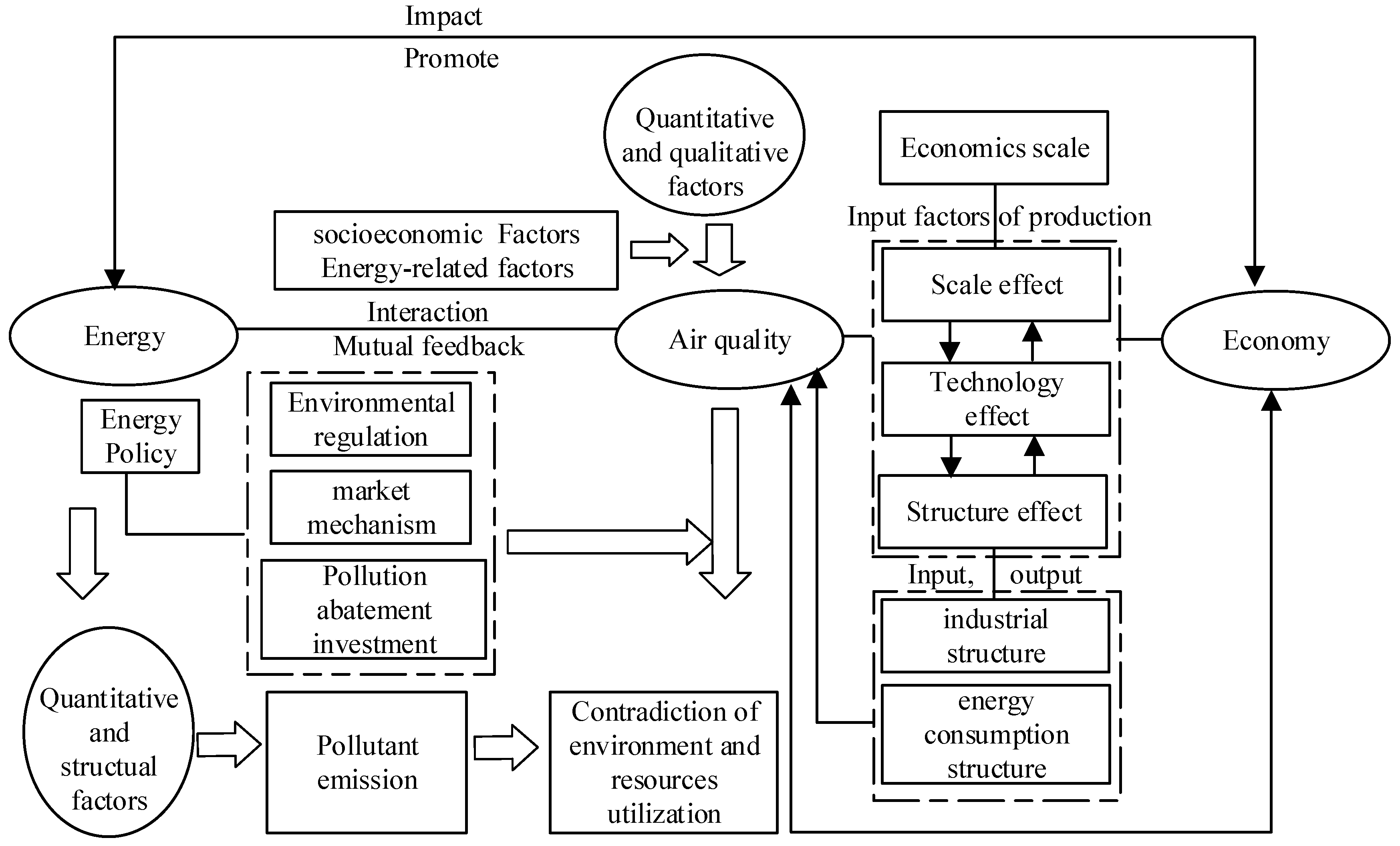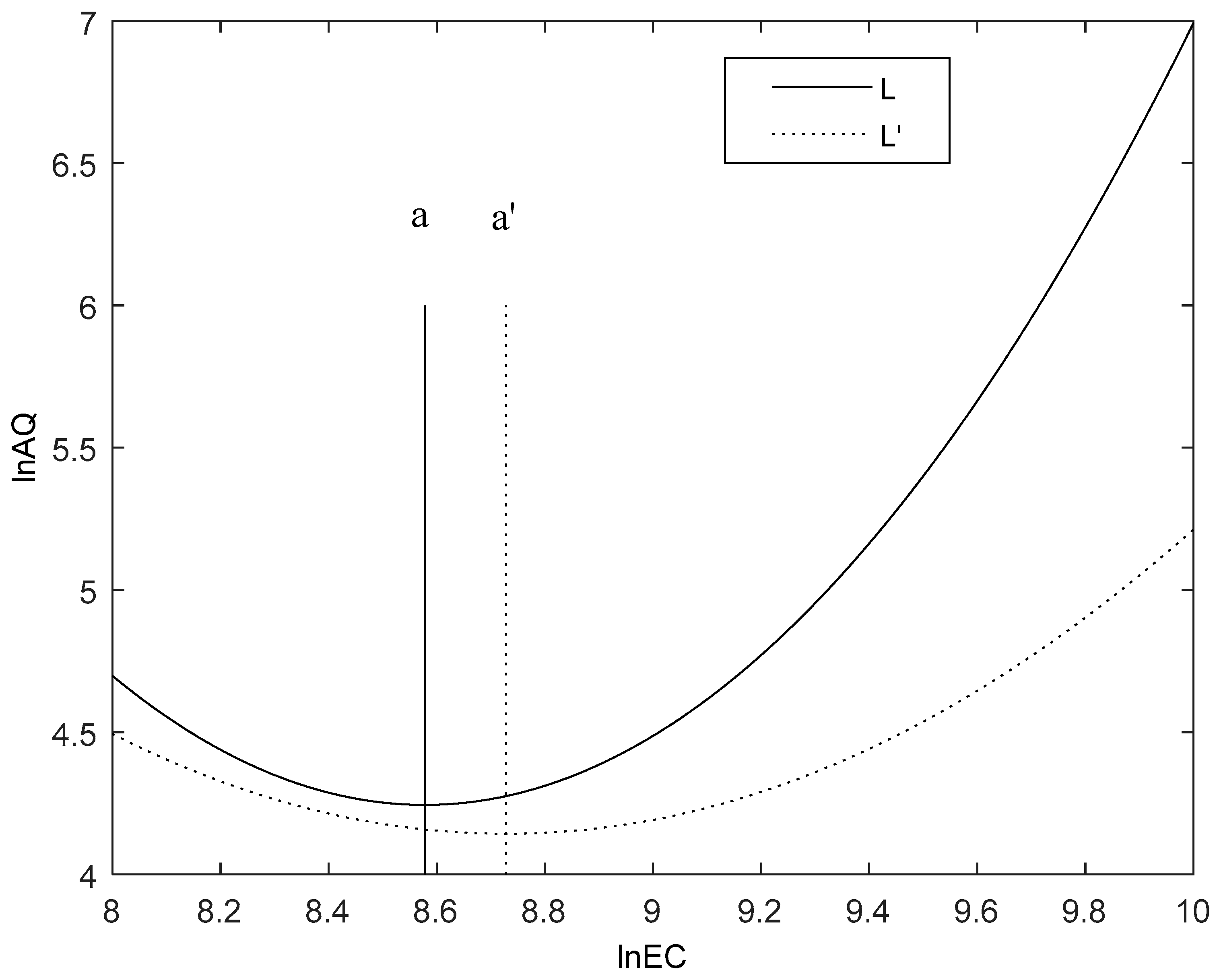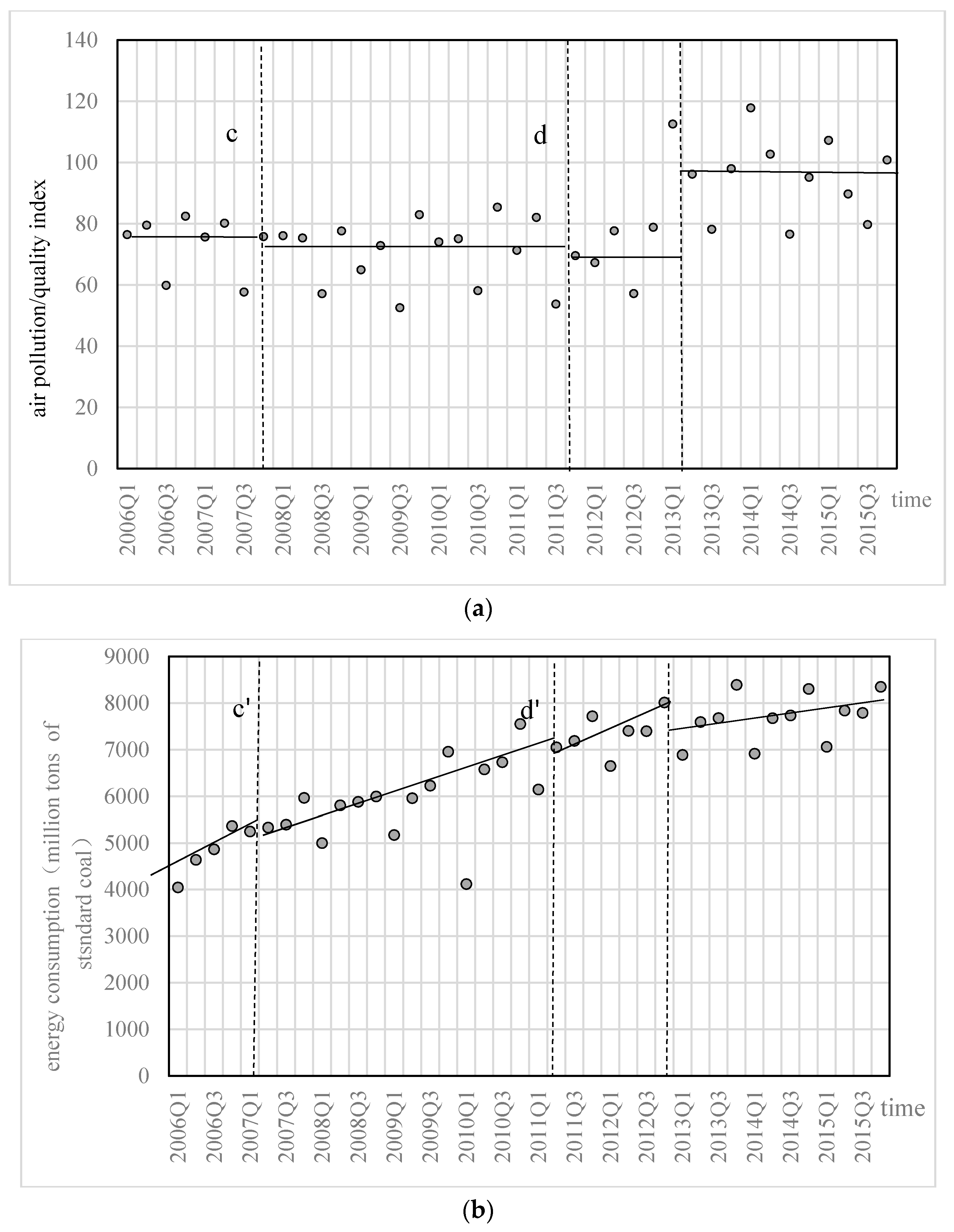Impact of Energy Consumption on Air Quality in Jiangsu Province of China
Abstract
:1. Introduction
2. Impact Mechanism of Energy Consumption on Air Quality
3. Decoupling the Relationship between Energy Consumption and Air Quality
4. Models and Data
4.1. Models
4.2. Data
4.2.1. Variables
4.2.2. Data Sources
5. Empirical Results and Analysis
5.1. General Model Estimates
5.2. Regression Discontinuity Design
5.2.1. Discontinuity Selection
5.2.2. Local Average Treatment Effect of Policy Implementation
5.3. Estimation Results
6. Conclusions
Acknowledgments
Author Contributions
Conflicts of Interest
References
- Wang, Z.S. Analysis on the current situation of energy consumption structure and environmental air quality in Tianjin province. Chin. Energy 2009, 31, 35–37. [Google Scholar]
- Yan, G. Model of the energy consumption pattern of Pearl River Felta under constraints of air quality. Acta Sci. Circumst. 2011, 31, 1493–1500. [Google Scholar]
- Amegah, A.K.; Agyei-Mensah, S. Urban air pollution in Sub-Saharan Africa: Time for action. Environ. Pollut. 2017, 220, 738–743. [Google Scholar] [CrossRef] [PubMed]
- Zhao, J.; Chen, S.; Wang, H.; Ren, Y.; Du, K.; Xu, W.; Zheng, H.; Jiang, B. Quantifying the impacts of socio-economic factors on air quality in Chinese cities from 2000 to 2009. Environ. Pollut. 2012, 167, 148–154. [Google Scholar] [CrossRef] [PubMed]
- Chen, Y.L.; Xie, B.G.; Yang, Y. Distribution of the urban air quality in the major city clusters in China and the influencing factors. J. Arid Land Resour. Environ. 2015, 11, 99–103. [Google Scholar]
- Sun, L.; Wei, J.; Duan, D.H.; Guo, Y.M.; Yang, D.X.; Jia, C.; Mi, X.T. Impact of land-use and land-cover change on urban air quality in representative cities of China. J. Atmos. Sol. Terr. Phys. 2016, 142, 43–54. [Google Scholar] [CrossRef]
- Awbi, H.B. Ventilation for good indoor air quality and energy efficiency. Energy Procedia 2017, 112, 277–286. [Google Scholar] [CrossRef]
- Van Zelm, R.; Preiss, P.; van Goethem, T.; Van Dingenen, R.; Huijbregts, M.; Van Dingenend, R.; Huijbregtsa, M. Regionalized life cycle impact assessment of air pollution on the global scale: Damage to human health and vegetation. Atmos. Environ. 2016, 134, 129–137. [Google Scholar] [CrossRef] [Green Version]
- Tang, G.; Zhao, P.; Wang, Y.; Gao, W.; Cheng, M.; Xin, J.; Li, X.; Wang, Y. Mortality and air pollution in Beijing: The long-term relationship. Atmos. Environ. 2017, 150, 238–243. [Google Scholar] [CrossRef]
- Young, S.S.; Richard, L.S.; Keneth, K.L. Air quality and acute deaths in California, 2000–2012. Regul. Toxicol. Pharmacol. 2017, 88, 173–184. [Google Scholar] [CrossRef] [PubMed]
- Alam, M.M.; Murad, M.W.; Noman, A.H.M.; Ozturk, I. Relationships among carbon emissions, economic growth, energy consumption and population growth: Testing Environmental Kuznets Curve hypothesis for Brazil, China, India and Indonesia. Ecol. Indic. 2016, 70, 466–479. [Google Scholar] [CrossRef]
- Lun, F.; Canadell, J.G.; Xu, Z.Q.; He, L.; Yuan, Z.; Zhang, D.; Li, W.H.; Liu, M.C. Residential energy consumption and associated carbon emission in forest rural area in China: A case study in Weichang County. J. Mt. Sci. 2014, 11, 792–804. [Google Scholar] [CrossRef]
- Khan, M.M.; Zaman, K.; Irfan, D.; Awan, U.; Ali, G.; Kyophilavong, P.; Shahbaz, M.; Naseem, I. Triangular relationship among energy consumption, air pollution and water resources in Pakistan. J. Clean. Prod. 2016, 112, 1375–1385. [Google Scholar] [CrossRef]
- Pan, D.; Chan, M.; Deng, S.; Lin, Z. The effects of external wall insulation thickness on annual cooling and heating energy uses under different climates. Appl. Energy 2012, 97, 313–318. [Google Scholar] [CrossRef]
- Sharmin, T.; Gül, M.; Li, X.; Ganev, V.; Nikolaidis, I.; Al-Hussein, M. Monitoring building energy consumption, thermal performance and indoor air quality in a cold climate region. Sustain. Cities Soc. 2014, 13, 57–68. [Google Scholar] [CrossRef]
- Song, M.L.; Zheng, W.P.; Wang, Z.Y. Environmental efficiency and energy consumption of highway transportation systems in China. Int. J. Prod. Econ. 2015, 9, 1–9. [Google Scholar] [CrossRef]
- Wang, F.; Wang, H.Y.; Wang, Y.L. Tests analysis of heating energy consumption and indoor air quality in northeastern rural dwellings of China. Procedia Eng. 2016, 146, 17–23. [Google Scholar] [CrossRef]
- Nasreen, S.; Anwar, S.; Ozturk, I. Financial stability, energy consumption and environmental quality: Evidence from South Asian economies. Renew. Sustain. Energy Rev. 2017, 67, 105–1122. [Google Scholar] [CrossRef]
- Yang, X.; Wang, S.; Zhang, W.; Li, J.; Zou, Y. Impacts of energy consumption, energy structure and treatment technology on SO2 emissions: A multi-scale LMDI decomposition analysis in China. Appl. Energy 2016, 184, 714–726. [Google Scholar] [CrossRef]
- Zhu, Z.Y.; Rao, L.Y.; Yu, X.X.; Zhu, M.X. Air quality and dynamic relationship with energy consumption structure in Beijing. Environ. Monit. China 2014, 30, 4–9. [Google Scholar]
- Mai, C.P.; Lian, S.Q.; Niu, S.W. Analysis of the energy consumption structure and the ambient air quality in Gansu province. J. Lanzhou Univ. Nat. Sci. 2014, 50, 508–512. [Google Scholar]
- Ru, L.J. Analysis on Consuming Present Situation of Energy and the Countermeasures of Improving Urban Environmental Air Quality in Taiyuan City; Taiyuan SCI-Tech: Taiyuan, China, 2003; pp. 18–19. [Google Scholar]
- Wu, L.J.; Cheng, W.Y.; Zhang, L. The relationship between energy consumption structure and the quality of atmospheric environment-an example in an area of Chengdu. Environ. Sci. Manag. 2009, 34, 166–169. [Google Scholar]
- Tsao, C.C.; Campbell, J.E.; Mena-Carrasco, M.; Spak, S.N.; Carmichael, G.R.; Chen, Y. Biofuels that cause land-Use change may have much larger Non-GHG air quality dmissions than fossil fuels. Environ. Sci. Technol. 2012, 46, 10835–10841. [Google Scholar] [CrossRef] [PubMed]
- Wang, Q.Y. Energy and environment: Problems and solutions in China. Energy Environ. 2005, 4, 4–11. [Google Scholar]
- Alvarez-Herranz, A.; Balsalobre-Lorente, D.; Shahbaz, M.; Cantos, J.M. Energy innovation and renewable energy consumption in the correction ofair pollution levels. Energy Policy 2017, 105, 386–397. [Google Scholar] [CrossRef]
- Borrego, C.; Coutinho, M.; Costa, A.M.; Ginja, J.; Ribeiro, C.; Monteiro, A.; Ribeiro, I.; Valente, J.; Amorim, J.H.; Martins, H.; et al. Challenges for a new air quality directive: The role of monitoring and modelling techniques. Urban Clim. 2015, 14, 328–341. [Google Scholar] [CrossRef]
- Martínez, C.I.P. Energy and sustainable development in cities: A case study of Bogotá. Energy 2015, 92, 612–621. [Google Scholar] [CrossRef]
- Han, Y.F.; Ma, M.T.; Song, L.Y. Analysis on the changing trend of atmospheric environment quality in Beijing in recent years. Environ. Sustain. Dev. 2009, 6, 4–6. [Google Scholar]
- Zhang, X.; Wu, L.; Zhang, R.; Deng, S.; Zhang, Y.; Wu, J.; Li, Y.; Lin, L.; Li, L.; Wang, Y.; et al. Evaluating the relationships among economic growth, energy consumption, air emissions and air environmental protection investment in China. Renew. Sustain. Energy Rev. 2013, 18, 259–270. [Google Scholar] [CrossRef]
- Wei, W.X.; Ma, X.L. Optimal policy for energy structure adjustment and haze governance in China. China Popul. Resour. Environ. 2015, 25, 6–14. [Google Scholar]
- Gratsea, M.; Liakakou, E.; Mihalopoulos, N.; Adamopoulos, A.; Tsilibari, E.; Gerasopoulos, E. The combined effect of reduced fossil fuel consumption and increasing biomass combustion on Athens’ air quality, as inferred from long term CO measurements. Sci. Total Environ. 2017, 592, 115–123. [Google Scholar] [CrossRef] [PubMed]
- Wang, W.; Li, Q.; Lou, Y.; Yang, X. Nexus of energy saving and air quality in China’s energy industries during the 12th Five Year Period. Energy Procedia 2017, 105, 3824–3829. [Google Scholar] [CrossRef]
- Xue, Y.; Tian, H.; Yan, J.; Zhou, Z.; Wang, J.; Nie, L.; Pan, T.; Zhou, J.; Hua, S.; Wang, Y.; et al. Temporal trends and spatial variation characteristics of primary air pollutants emissions from coal-fired industrial boilers in Beijing, China. Environ. Pollut. 2016, 213, 717–726. [Google Scholar] [CrossRef] [PubMed]
- Jayasooriya, V.M.; Ng, A.; Muthukumaran, S.; Perera, B.C. Green infrastructure practices for improvement of urban air quality. Urban For. Urban Green. 2017, 21, 34–47. [Google Scholar] [CrossRef]
- Grossman, G.; Krueger, A. Environmental impacts of a North American free trade agreement. Soc. Sci. Electron. Publ. 1992, 8, 223–250. [Google Scholar]
- Ma, L.M.; Zhang, X. The Spatial effects of China’s haze pollution and the impact on economy and energy structure. China Ind. Econ. 2014, 4, 19–31. [Google Scholar]
- Wang, L.P.; Chen, J. Socio-economic influential factors of haze pollution in China: Empirical study by EBA model using spatial panel data. Acta Sci. Circumst. 2016, 36, 3833–3839. [Google Scholar]
- Shao, S.; Li, X.; Cao, J.H.; Yang, L.L. Economic policy choice of china’s haze management-From the perspective of spatial spillover effect. Econ. Res. 2016, 9, 73–88. [Google Scholar]
- Wang, L. Study on Industrial Structure Optimization of Jiangsu Province under Environmental Constraints; Jiangnan University: Wuxi, China, 2008. [Google Scholar]
- Omer, A.M. Energy, environment and sustainable development. Renew. Sustain. Energy Rev. 2008, 12, 2265–2300. [Google Scholar] [CrossRef]
- Du, X.W.; Yang, B.; Liu, X.L. Decoupling analysis of China’s economic development, energy consumption and carbon emission. China Popul. Resour. Environ. 2015, 25, 1–7. [Google Scholar]
- Apergis, N.; Christou, C.; Gupta, R. Are there environmental kuznets curves for US state-level CO2 emissions? Renew. Sustain. Energy Rev. 2017, 69, 551–558. [Google Scholar] [CrossRef]
- Arrow, K.; Bolin, B.; Costanza, R.; Dasgupta, P.; Folke, C.; Holling, C.S.; Jansson, B.O.; Levin, S.; Mäler, K.G.; Perrings, C.; et al. Economic growth, carrying capital and environment. Science 1995, 286, 520–521. [Google Scholar] [CrossRef] [PubMed]
- Jiang, L.; Folmer, H.; Ji, M. The drivers of energy intensity in China: A spatial panel data approach. China Econ. Rev. 2014, 31, 351–360. [Google Scholar] [CrossRef]
- Wu, F.L.; Zhou, Y.; Chen, J.H. An empirical study on the relationship between energy consumption and economic development in China. J. Cent. South Univ. Soc. Sci. 2013, 19, 29–35. [Google Scholar]
- Zhou, J.Q. Study on the convergence of carbon intensity and its influencing factors in China. J. Guangdong Univ. Financ. Econ. 2014, 2, 12–20. [Google Scholar]
- Casson, M.C.; Giusta, M.D.; Kambhampati, U.S. Formal and informal institutions and development. World Dev. 2010, 38, 137–141. [Google Scholar] [CrossRef]
- Zhang, X.G.; Zhong, M.C. A further study on the environmental kuznets curve-from the perspective of government regulation. J. Zhongnan Univ. Econ. Law 2009, 50, 40–44. [Google Scholar]
- Hahn, J.; Todd, P.; Van der Klaauw, W. Identification and estimation of treatment effects with a regression-discontinuity design. Econometrica 2001, 69, 201–209. [Google Scholar] [CrossRef]
- Lee, D.; Lemieux, T. Regression discontinuity designs in economics. J. Econ. Lit. 2010, 48, 281–335. [Google Scholar] [CrossRef]
- Cook, T. Waiting for life to arrive: A history of the regression-Discontinuity design in psychology, statistics and economics. J. Econom. 2008, 142, 636–654. [Google Scholar] [CrossRef]
- Meng, L. Evaluating China’s poverty alleviation program: A regression discontinuity approach. J. Public 2013, 101, 1–11. [Google Scholar] [CrossRef]
- Xu, Q. Research on the benchmarking methods of quarterly GDP and annual GDP. Stat. Res. 2003, 3, 19–23. [Google Scholar]
- Wang, X.; Feng, Z. Energy consumption with sustainable development in developing country: A case in Jiangsu, China. Energy Policy 2003, 31, 1679–1684. [Google Scholar] [CrossRef]
- Zhou, N.; Levine, M.D.; Price, L. Overview of current energy-efficiency policies in China. Energy Policy 2010, 38, 6439–6452. [Google Scholar] [CrossRef]
- Zhong, Z.; Huang, R.; Tang, Q.; Cong, X.; Wang, Z. China’s provincial CO2 emissions embodied in trade with implications for regional climate policy. Front. Earth Sci. 2015, 9, 77–90. [Google Scholar] [CrossRef]
- Zhang, Y.J.; Da, Y.B. The decomposition of energy-related carbon emission and its decoupling with economic growth in China. Renew. Sustain. Energy Rev. 2015, 41, 1255–1266. [Google Scholar] [CrossRef]
- Wang, J.J.; Shi, D.; Zhang, C. The impact of energy price on energy efficiency: An empirical analysis based on global data. Econ. Manag. 2014, 12, 13–23. [Google Scholar]
- Xu, L.N.; Zhao, T.; Liu, G.W.; Sun, J.S. Analysis on dynamic effect of energy intensity change and energy structure and industrial structure in China. Inq. Econ. Issues 2013, 7, 40–44. [Google Scholar]
- Govindaraju, V.G.R.C.; Tang, C.F. The dynamic links between CO2 emissions, economic growth and coal consumption in China and India. Appl. Energy 2013, 104, 310–318. [Google Scholar] [CrossRef]
- Hao, Y.; Zhang, Z.Y.; Liao, H.; Wei, Y.M. China’s farewell to coal: A forecast of coal consumption through 2020. Energy Policy 2015, 86, 444–455. [Google Scholar] [CrossRef]
- Dong, X.B.; Yin, J.J.; Wen, Y.B. Environmental quality, governmental regulation and economic growth: An extensive endogenous framework. China Natl. Law Econ. Collect. Pap. 2012, 6, 49–62. [Google Scholar]
- Gao, C.Y.; Lian, S.Q.; Niu, S.W. Status of industrial energy consumption and air pollution of three cities in Western China. J. Lanzhou Univ. Nat. Sci. 2014, 50, 240–244. [Google Scholar]
- Li, J.L.; Zeng, T. Analysis on the principal component of factors affecting air quality in Beijing: From 2000–2011 years of experience data. Ecol. Econ. 2017, 189, 167–171. [Google Scholar]
- Xie, L.F.; Yan, C.M.; Li, G.X.; XU, Y.C.; Zhang, Y.; Zhao, Y.W. Responses of water environment pollution in industrial structure of Jiangsu Province. Bull. Soil Water Conserv. 2016, 2, 307–313. [Google Scholar]
- Xi, P.H.; Liang, R.B. The impact of air pollution on local government’s environmental protection investment-based on multi-regression discontinuity design. Stat. Res. 2015, 32, 76–83. [Google Scholar]
- Brollo, F.; Nannicini, T.; Perotti, R.; Tabellini, G. The political resource curse. Am. Econ. Rev. 2013, 103, 1759–1796. [Google Scholar] [CrossRef]
- Liu, S.L.; Zhou, S.J.; Hu, A.G. Compulsory education law and the return rate of urban education in China: Based on regression discontinuity design. Econ. Res. 2016, 2, 154–167. [Google Scholar]






| Variable | Symbol | Unit | Index Description |
|---|---|---|---|
| Total energy consumption | EC | ten thousand tons of standard coal | energy consumption (Standard coal equivalent) |
| Air quality | AQ | / | measured with API and AQI |
| Economic aggregate | GDP | million yuan | the gross regional domestic product |
| Industrial structure | S | / | the proportion of the tertiary industry added value account for GDP |
| Energy efficiency | E | million yuan/ten thousand tons of standard coal | the reciprocal of energy intensity, the “unit energy consumption of GDP” (GDP/total energy consumption) |
| structure of energy consumption | ECS | / | the proportion of coal consumption account for total energy consumption |
| Parameter | Estimated Value | Standard Deviation | T Statistic | p Value |
|---|---|---|---|---|
| 54.5467 | 61.1095 | 0.8947 | 0.3772 | |
| −11.5494 | 14.1032 | −0.8189 | 0.4185 | |
| 0.6616 | 0.8130 | 0.8137 | 0.4215 | |
| 0.1904 | 0.1745 | 1.0910 | 0.2829 | |
| 0.3517 | 0.2197 | 1.6009 | 0.1186 | |
| −0.4480 | 0.3273 | −1.3687 | 0.1801 | |
| R2 | 0.3388 | mean of dependent variable | 4.3477 | |
| adjusted R2 | 0.2416 | Standard deviation of dependent variable | 0.1990 | |
| residual sum of squares | 1.0206 | Durbin-Watson statistic | 2.2276 | |
| F statistic | 3.4850 | probability (F statistics) | 0.0119 ** | |
| Variable | Coefficient | Standard Deviation | T Statistic | p Value |
|---|---|---|---|---|
| 2006Q1–2007Q2 | ||||
| LnEC | 0.5086 | 0.0051 | 99.9779 | 0.0000 |
| 2007Q3–2011Q2 | ||||
| LnEC | 0.4893 | 0.0042 | 115.5377 | 0.0000 |
| 2011Q3–2012Q4 | ||||
| LnEC | 0.4716 | 0.0054 | 86.8691 | 0.0000 |
| 2013Q1–2015Q4 | ||||
| LnEC | 0.5095 | 0.0052 | 97.8075 | 0.0000 |
| ① | ② | ③ | ||
| Logarithmic energy consumption simplified equation | ||||
| 0.0273 (0.0745) | 0.0830 (00687) | |||
| 0.1800 (0.0161) | 0.1993 (0.0627) | |||
| R2 | 0.6740 | 0.7379 | 0.7487 | |
| Logarithmic air quality simplification equation | ||||
| −0.2469 (0.01012) | −0.2712 (0.1049) | |||
| −0.0234 (0.0998) | −0.0866 (0.0958) | |||
| R2 | 0.4225 | 0.3252 | 0.4360 | |
| Logarithmic air quality structural equation | ||||
| Parameter | Estimated Value | Standard deviation | T statistic | p value |
| 202.3432 | 18.6481 | 10.8506 | 0.0000 *** | |
| −44.7747 | 4.2625 | −10.5045 | 0.0000 *** | |
| 2.5238 | 0.2433 | 10.3717 | 0.0000 *** | |
| −0.0054 | 0.0358 | −0.1505 | 0.8813 | |
| 0.8143 | 0.0684 | 11.9113 | 0.0000 *** | |
| −1.0676 | 0.0923 | 11.9113 | 0.0000 *** | |
© 2018 by the authors. Licensee MDPI, Basel, Switzerland. This article is an open access article distributed under the terms and conditions of the Creative Commons Attribution (CC BY) license (http://creativecommons.org/licenses/by/4.0/).
Share and Cite
He, L.; Zhong, Z.; Yin, F.; Wang, D. Impact of Energy Consumption on Air Quality in Jiangsu Province of China. Sustainability 2018, 10, 94. https://doi.org/10.3390/su10010094
He L, Zhong Z, Yin F, Wang D. Impact of Energy Consumption on Air Quality in Jiangsu Province of China. Sustainability. 2018; 10(1):94. https://doi.org/10.3390/su10010094
Chicago/Turabian StyleHe, Lingyun, Zhangqi Zhong, Fang Yin, and Deqing Wang. 2018. "Impact of Energy Consumption on Air Quality in Jiangsu Province of China" Sustainability 10, no. 1: 94. https://doi.org/10.3390/su10010094




